Curran Point Napoleonic Tower and Battery
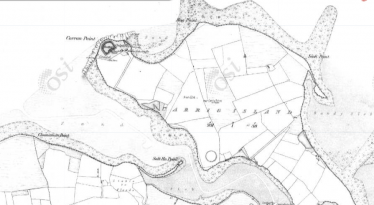
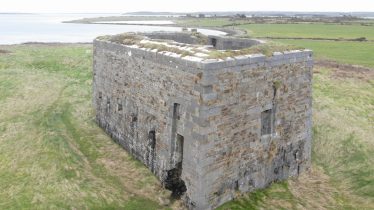
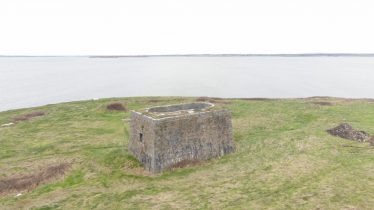
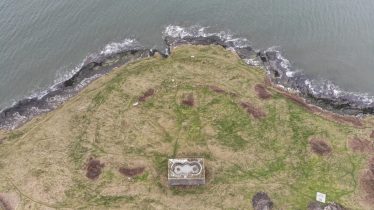

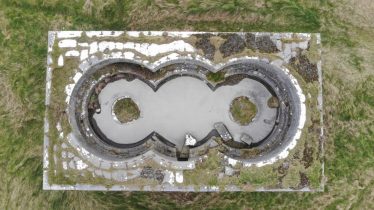
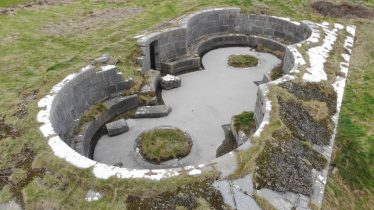
Reasons for construction.
Since Theobald Wolfe Tone and the Society of United Irishmen attempted to rally France behind the Irish cause in the 1790s and with the coming to power of Napoleon Ireland was seen as the likely landing place for an invasion force. The Mouth of the Shannon was one of the three invasion areas ( the others were Galway and Bantry Bay) included in the French Directory’s instructions to Vice- Admiral Villaret de Loveuse in October 1796, during the preparations of an expedition to Ireland.This led to the British Admiralty constructing the a system of Signal Stations (51) as observation posts, together with 50 Martello towers, each maintaining a garrison of troops, officers and heavy artillery.
In addition to these a total of 10 quadrangular towers protecting batteries were built in Ireland between 1809 and 1817 on the coast in places that were particularly vulnerable to invasion. Seven were built to defend the River Shannon which was thought to be place the invasion was most likely to take place as it provided access to Limerick and the centre of Ireland. Six of these quadrangular towers were constructed along the shores of the Shannon Estuary below Limerick, Tarbert and Carrig Island on the south shore and Kilcredaun, Doonaha, Scattery Island and Kilkerrin on the north shore. The other one was built on the Upper Shannon to defend a ford at Keelogue below Athlone. Two others were built on the shores of Lough Swilly in County Donegal and one on Bere Island in Bantry Bay in County Cork.
Description of the Quadrangular Towers and Batteries.
These Quadrangular towers were always to be found closing the gorge of a detached battery and were there to protect the battery from a landward side attack as well as cover for the battery of 24 pounder guns.
The batteries housed the gunners and the ordinary troopers. It was well defended by deep dry moats and was bombproof.All the 10 batteries formed a D-shaped enclosure in plan with masonry on the the scarp and counterscarp of the dry moat . Entrance to the batteries was across a drawbridge over the dry ditch or moat. The defensible guardhouses were entered from within the battery by a drawbridge slightly wider than the entrance doorway, over which the keystone bears the dates of construction. The guardhouses had basements or lower ground floors, level with the base of the dry moat in which it stands. The upper floor, level with the ground level of the battery, was approached by the drawbridge; above this floor level is the gun platform carried on the barrel-vaulted ceiling of the first-floor apartments.Musket-loops were provided at the lower levels, allowing for close defence of the moat in the manner of a caponnière. Musket-loops at the upper floor levels, were fitted with shutters on the outer face of the wall, commanded the interior of the battery. Other loops are arranged on the opposite side at this level, facing the approach to the rear of the battery on the landward side. On the roof-level gun platform, protected by broad parapets some six feet in height, were two guns mounted on traversing platforms: howitzers or carronades for defence of the landward side of the battery and they fired exploding projectiles. The traversing platforms, one at each end of the roof, enabled the guns to be trained through an angle of about 270 degrees, covering the ground on each flank of the battery and to the rear.
The main armament of the battery consisted of six 24-pounder guns mounted on traversing platforms, each revolving on a front pivot behind the inner face of the parapet.The range of the 24 pounder guns was 2km.Most of the guns could be simultaneously pointed at the same point. They fired either hot cannon shots to set fire to a vessel or cold shots to sink a vessel. The cannon shots were held in a bomb proof section within the barracks.
The batteries also provided protection for vessels anchored within range of their guns, otherwise vulnerable to attack by enemy ships of war or privateers. In 1804 the gunboat establishment in Ireland included five gun vessels in the Shannon Estuary armed with 18-pounder guns and 32-pounder and 18-pounder carronades.These small craft operating in the shallow waters of the estuary could not be pursued by deeper-draught vessels such as ships of the line or frigates.
Curran Point Napoleonic Tower and Battery
This site is situated on the coastline of Carrig Island and is directly across from Slattery Island. To the NE lies Moneypoint – to the south lies Carrigfoyle Castle. The view from this site is excellent in all directions. This site is marked on both the 1840-41 and 1914-15 editions of the OS maps.
The main building of the battery which was constructed of dressed stone still remains. The North side measures 16.3m in length, It displays a semi-circular headed dressed doorway which has two pulleys attached, to draw up the door. It also displays four small rectangular windows which measures 0.9m in length.
The south side has no windows or doorway but in the interior running along the wall from the first floor to the roof is a stairway. The eastern side measures 9.85m in length and displays one large window and two small rectangular ones. The western side also has one large window and four small rectangular ones. This site is situated on the coastline and is directly across from Scattery Island. To the NE lies Moneypoint – to the south lies Carrigfoyle Castle. The view from this site is excellent in all directions. The surrounding land is pastureland. This site is marked on both the 1840-41 and 1914-15 editions of the OS maps.
The main building of the battery which was constructed of dressed stone still remains. The North side measures 16.3m in length, It displays a semi-circular headed dressed doorway which has two pulleys attached, possibly to draw up the door. It also displays four small rectangular windows which measures 0.9m in length.The moat and the battery elements are long gone and just the tower remains as symbol of a lost empire.
The south side has no windows or doorway but in the interior running along the wall from the first floor to the roof is a stairway. The eastern side measures 9.85m in length and displays one large window and two small rectangular ones. The western side also has one large window and four small rectangular ones. The date is probably early 19th century. In 1889, the artillery garrison was withdrawn and the great guns were dismantled.




No Comments
Add a comment about this page